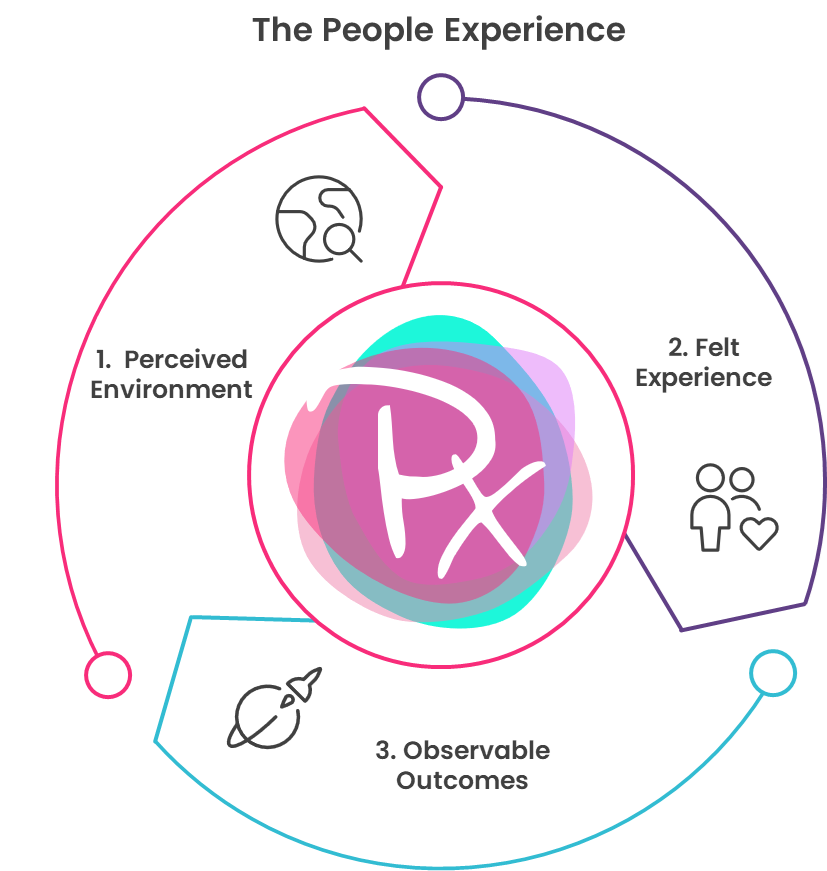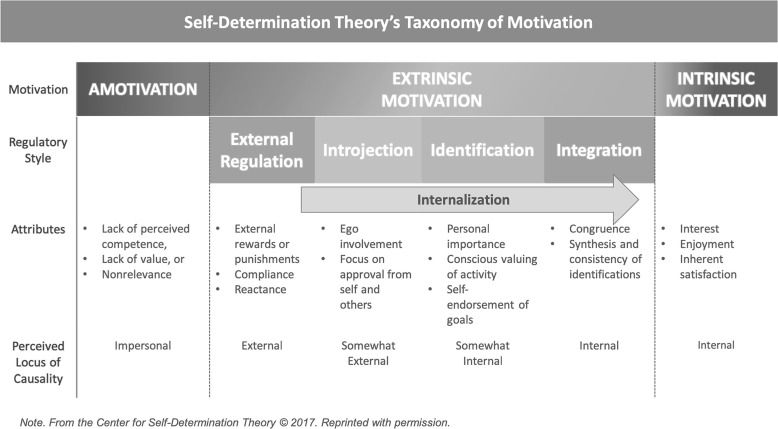Recently I was asked by Naomi, our Head of Sales and Marketing, what I thought about Intrinsic Motivation. And while the short answer is that it’s pretty influential in my work, I thought I’d take the time to outline my thoughts on how it relates to the People Experience and, more specifically, Employee Engagement.
What is Employee Engagement?
That might seem like a daft question, but there are many different models and measures of employee engagement, and few have been scrutinised through peer-reviewed research. One definition that has, however, is Shuck and colleagues’:
"a positive, active, work-related psychological state operationalized by the maintenance, intensity, and direction of cognitive, emotional, and behavioural energy.”
In everyday language, it’s saying that engaged employees are focused, emotionally committed to the organisation, and work hard (to exceed expectation).
Or, you might say, motivated.
What do we mean by the People Experience?
We differentiate the People Experience from Employee Engagement because it’s a broader and more holistic concept that helps us to provide flexibility and better understand what’s going on for their people.
The People Experience Hub framework:

In our three level framework, we’d put Employee Engagement as described above into our pot of Observable Outcomes. But another way of describing Employee Engagement is as a process, and in some respects our model represents that process. Into the first level of our model, Perceived Environment, goes the organisational practices, processes and structures that influence the People Experience. Even if that environment is more or less the same for everybody, we can all experience it differently. You might love it and I might hate it. Which is where our personalities, values and beliefs come into the picture. So this second level, the Felt Experience, is much more individual. Into that pot we’ve put feelings of Belonging, Purpose, (Emotional) Connection, Enjoyment, Autonomy and Growth. And in turn, those feelings influence our attitudes, behaviours and energy levels - our third level.
What is Intrinsic Motivation?
Intrinsic Motivation is when we are motivated do something not because of what it will lead to (e.g. reward or punishment), but because it’s satisfying in itself, enjoyable or interesting. Self-Determination Theory (Deci & Ryan, 1985) suggests that intrinsically motivated behaviour is facilitated by conditions that satisfy three basic psychological needs
that are essential to healthy human function, namely autonomy, competence and relatedness. These needs are viewed as: > “a psychological nutrient that is essential for individuals’ adjustment, integrity, and growth” While it’s not particularly new, Self-Determination (or SDT) and the idea of intrinsic motivation has gained much more traction in the HR world in the last few years. That’s in part because it was popularised by Dan Pink in his book Drive (although his version is slightly different to the original concept).
Why is intrinsic motivation important at work?
Intrinsic motivation is considered, generally, to be “good” motivation as it promotes personal growth and wellbeing. At work it has also been shown to be positively related to positive outcomes – including employee engagement and performance - as well as being negatively related to negative outcomes - turnover intentions, burnout and work-family conflict. So it’s not just that intrinsic motivation is good for business, but relying too heavily on extrinsic motivation (carrot and stick) could be bad for it and can even undermine motivation overall. That is, if you reward someone for doing something that they would do anyway, and you take away the reward, they are less likely to do it than they would have been in the first place! It’s probably true that there are some jobs that people wouldn’t particularly choose to do if they didn’t need the money, and we’re generally not queuing up to work for free. This suggests that intrinsic and extrinsic motivation are not binary states, but indeed that they exist on a continuum and that at different times different aspects of work are relatively intrinsically or extrinsically motivating.
Intrinsic Motivation and Extrinsic Motivation as a continuum, from Self-Determination Theory:

Let’s think about that for a moment. There may be some things that you only do because you’re being paid, and not doing it will have repercussions. So you suck it up and do them. This is extrinsic motivation. There are some things that you do because you believe it’s important, in the context of your job, to do it well. We certainly don’t mind doing it and may generally feel good about it. This is a situation in which both intrinsic and extrinsic motivation may apply. There are other things that you love to do, that happen to be part of your job. This is intrinsic motivation.
What drives intrinsic motivation?
So, let’s look a bit more closely at intrinsic motivation and the conditions that promote it. There are three basic psychological needs (according to Self-Determination Theory) that when met promote intrinsic motivation and, therefore, wellbeing and personal growth.
Basic Psychological Needs that facilitate Intrinsic Motivation:

Autonomy is about feeling a degree of freedom to make choices about what you do, and experiencing a sense of integrity, for example with your own values. In this sense, autonomy is not absolute but relative. For example, if you’re an accounts assistant your role is constrained, but you may still have opportunities to make small decisions and you shouldn’t feel that you have to act against your own sense of ethics. It also doesn’t mean that by subscribing to the vision and mission of your company or working towards company objectives, you are not exercising autonomy. It’s a matter of how willing you are.
Competence is about experiencing activities that provide opportunities to use and extend your expertise and skills, and to be effective. This means that it’s important not only to make sure that people have opportunities to train but to support their effectiveness and remove barriers, such as ineffective processes or an overly critical manager. These can frustrate the need for competence and create a sense of failure or helplessness.
Relatedness is about experiencing the warmth, bonding and care that comes from meaningful relationships. It is both being able to connect with and feel significant to others. This is very close to a feeling of belonging, both in terms of inclusion but also in the emotional connection that is shared with others. Relatedness is, I think, more than about what you get as an individual from your relationships, but also opportunities to give (e.g. support and care) or connect beyond one’s self (e.g. with the community, organisation or a cause).
What about Purpose?
This last point aligns with Dan Pink’s version of the theory, which emphasises Purpose (a greater good or cause) rather than Relatedness. In my view this isn’t fundamentally different to the original theory, but it is narrower.
What does this mean for the People Experience?
First, there is a strong evidence base to support Self-Determination Theory and the idea that if you create conditions that support autonomy, competence and relatedness at work, it will have a positive impact on motivation and, potentially, wellbeing. So, if you: - Give people to influence their work and exercise choice in ways that are appropriate and proportionate to their role; - Help people to develop and make the most of their skills by supporting them or getting rid of things that get in the way; and - Help people to build relationships at work, to develop shared experiences, care and feel cared for; it’s fair to say that you’re delivering a positive people experience.
OK, so what about employee engagement?
Much of the research into intrinsic motivation and employee engagement places intrinsic motivation as an antecedent (driver) of engagement. That aligns well with the ‘process’ view of employee engagement, that we make appraisals of our working environment (how well does it satisfy our needs) and that in turn drives engagement. So, broadly speaking, the same conditions that support intrinsic motivation also facilitate employee engagement.
So is Intrinsic Motivation a panacea for organisations?
To be honest, I think it’s a really nice way of thinking about the work environment. Just three things to guide the way that you: - Manage people - Design work roles and structure - Build systems and process - Implement change.. and so on. No theory is perfect, so it’s perhaps not a panacea, but one of the most important things a theory can be is useful. And I think that Intrinsic Motivation, or more precisely Self-Determination Theory, and its three basic psychological needs, provide a really useful platform for thinking about the People Experience. Referring back to our own model, it’s no accident that our dimensions of Belonging, Purpose, (Emotional) Connection, Enjoyment, Autonomy and Growth are all pretty closely related to Intrinsic Motivation in some way.
Fancy getting in touch? Email us at hello@pxhub.io
